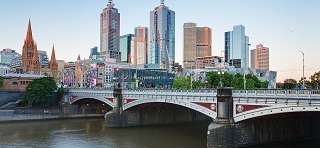


Image: Melbourne skyline, David Iliff, https://creativecommons.org/licenses/by/3.0/deed.en (cropped)

Image: Melbourne skyline from Wiliamstown, Jorge Lascar, https://creativecommons.org/licenses/by/2.0/deed.en (cropped)
Melbourne today is a large city of 4.5 million people and the capital of the state of Victoria. Scattered whaling outposts were already operating in the area when Melbourne was founded in 1835. It was set up as a remote port by two groups of enterprising pastoralists seeking to open up the vast unexplored inland region for farming. But they soon also found gold. It turned out to be the seventh largest gold reserves in the world. Explosive immigration during the ensuing gold rush from 1851 to 1890 turned Melbourne into a large city. Today the many majestic buildings, museums and galleries built with wealth from that era are intermingled in strong contrast amongst the glass skyscrapers of modern Melbourne.
A richly cosmopolitan city from the wide spread immigration, Melbourne residents regard their city as the most elegant and cultured in the country. This is reflected in the variety of cuisine and vibrant outdoor cafe culture. The marvelous colonial city buildings, wide tree-lined boulevards, and large formal parks and gardens that surround the well planned city centre give Melbourne a distinctly European feel. Melbourne is understated, not at all brash, and most visitors go away pleasantly satisfied. On warm summer days and evenings many Melburnians flock to the trendy beachside suburb of St Kilda to lay in the sand, dip in the water and dine and drink at its bars and restaurants. Melbourne has a strong emphasis on the arts. But the biggest drawcards to the city are its powerful annual line up of major international sporting events.
Although Melbourne is set on a large and somewhat picturesque bay with many beaches on the eastern side, the best natural beauty is further afield. The 300 kilometre long Great Ocean Road in southwest Victoria is one the most spectacular rugged coastal drives in the world.
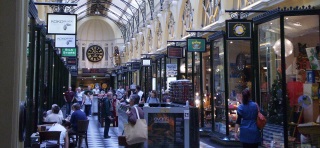
Image: Royal Arcade, Collins Street, Melbourne, Alpapad, https://creativecommons.org/licenses/by-sa/3.0/deed.en (cropped)
Collins Street has always been the most exclusive and prestigious street in Melbourne. Ornate office buildings and banks , graceful churches, and high end retail boutiques like Louis Vuitton and Armani line much of its length. Many of the buildings are gold rush era from the 1880s and have significant heritage value today. The glass skyscrapers of modern Melbourne rise high into the sky behind them.
Highlights you will see walking along Collins Street include Scots Church and St Michaels Church, both on the corner of Collins Street and Russell Street. The Old Treasury Building facing down the street from its the east end now houses Melbourne City Museum (closed Saturday). Inside it explaining the gold rush period, has some old maps and photographs of Melbourne and you can go into the vaults where the gold was kept. http://www.oldtreasurybuilding.org.au
In the central shopping area between Swanston Street and Elizabeth Street, are some opulent arcades running from Collins Street through to adjacent streets. The Block Arcade is the centrepiece and most well known. Many are filled with clothes retailers and outdoor cafes for a lunch stop, making a handy break from your sightseeing walk. You will feel like a true Melbournian having lunch at the laneway cafes! If it is a coffee, sandwich or cake you are after we especially like the gorgeous French-style Laurent Bakery opposite the back of the Block Arcade on Little Collins Street.
With gold brought banks, and further west along Collins Street, the ornate gothic Royal Banking chambers at the corner Queens Street has a free banking museum. On show are old coins, antique office equipment and gold mining-equipment. A little further along, in a narrow side alley is Mitre Tavern, one of the oldest pubs in Melbourne if you are thirsty for a beverage. Further west again are the ornate Olderfleet Buildings, now part of the 5-star Le Meridian Hotel.
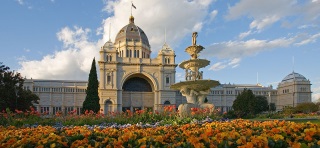
Image: Royal Exhibition Building, Melbourne, taken by Diliff and straightened by Ian Fieggen, https://creativecommons.org/licenses/by-sa/3.0/deed.en (cropped)
Melbourne is the capital of the State of Victoria. The State Parliament building was built in neo-classical style in 1856 and faces down Bourke Street from the east end of the city centre. Free guided tours are available when parliament is not sitting, or when it is, anyone can sit in the visitors gallery. Parliament has two chambers the Legislative Assembly decorated in green and the Legislative Council decorated in red, a colour scheme adopted from the Houses of Parliament at Westminster in London. http://www.parliament.vic.gov.au
Behind Parliament is the immense blue stone buttressed St Patricks Cathedral. It is the main Catholic cathedral in Melbourne. http://www.cam.org.au/cathedral
The Royal Exhibition Building in the quiet Carlton Gardens at the north end of Exhibition Street has a magnificent exterior. It was constructed for Australian Centenary celebrations in 1888 commemorating 100 years since first European settlement in Australia. The building then served as the Parliament of Australia from the time when the six Australian colonies gained independence from Britain and voted to federate in 1901 until the purpose built national capital was established in 1927.
Flinders Street Railway Station is the main metropolitan train station and the current building was constructed in 1900. Its gold and red facade makes it easy to spot. The main entrance is at the corner of Flinders Street and Swanston Street. Diagonally opposite is the neo-gothic St Pauls Cathedral which is the main Anglican cathedral in Melbourne. www.stpaulscathedral.org.au
The old neo-gothic General Post Office on the corner of Bourke Street and Elizabeth Street designated the centre of Melbourne and is now a clothes boutique. Next door on the Bourke Street Mall is the art deco Myer department store, and next to that and opposite, the David Jones department store - both historical buildings.
The State Library of Victoria, on Swanston Street at the corner of Latrobe Street, again built in neo-gothic style, boasts over one million books. The reading room under its giant copper dome is its focal point.
Queen Victoria Market at the northern end of the city centre is large bustling and full of character with its Eastern European style delicatessens, butchers, fruit and vegetable grocers, clothes stalls, and cheap watch, toy and souvenir sellers. It is well worth visiting and a highlight in any true Melbourne experience. Mornings are busier, but it is not open everyday so check. Located at the corner of Elizabeth Street and Victoria Street.
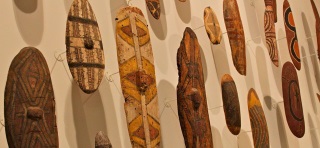
Image: Native warrior shields, National Gallery of Victoria (NGV), Melbourne, Travis, https://creativecommons.org/licenses/by/2.0/deed.en (cropped)
The National Gallery of Victoria has two major galleries. http://www.ngv.vic.gov.au/visit/
One is the Ian Potter Centre which houses what is without doubt the finest collection of paintings by early Australian settlers, together with some aboriginal art and modern art. The centrepiece work is "The Pioneer" (1904) by Frederick McCubbin. You will find the Ian Potter Centre buried away towards the back of the muddled cluster of buildings at Federation Square. This square is the modern plaza opposite the Flinders Street Station main entrance and its buildings easily identifiable from the disordered triangle-shaped cladding they all have - architects think the style is exciting. The official Melbourne Information Centre is also in the square.
However, the main art gallery building is over the Swanston Street bridge in the large austere brutalist rectangular grey stone building surrounded by a moat facing St Kilda Road. It houses a good collection of international art, both historical and contemporary, and includes native carvings from the Pacific Islands and some ancient Greek and Egyptian artifacts. The Asian collection is particularly good, and the set up in the kids area on teh ground floor is really creative and fun for little ones.
Entry to both galleries is free except to special exhibits.
There are at least several small private galleries with art for sale along Flinders Lane in the eastern end of the city, including especially Aboriginal art.
Melbournians are sports crazy, the city hosts a powerful line up of major national and international sports events, and it is fitting that the National Sports Museum is at the Melbourne Cricket Ground (MCG). http://www.nsm.org.au/
Australia was first settled only 220 years ago. Aside from the native Aboriginal people, just about everyone living in Australia would have family that immigrated not too long ago. The old Customs House building on Flinders Street on the cormer of Queen Street opposite the river has been converted into a what is now the Immigration Museum telling the story of the varied immigrant groups.
Melbourne has perhaps the largest Greek speaking population of any city in the world after Athens and Thessaloniki, with an unofficial estimate of 350,000 Greek speakers amongst the total city population. Through the help of wealthy local Greek donors, the Hellenic Museum has acquired a decent collection of Greek antiquities. The museum is in the old Royal Mint building on Willaim Street at the corner of La Trobe Street. Other than this museum, there is not much Greek feel on show in the city. There is sadly not much more than a few Greek restaurants left in what was the Greek quarter on Lonsdale Street between Swanston and Russell Streets. It is increasingly overrun with Chinese restaurats.
Chinese first also came to Australia in significant numbers during the gold rush, and many more since. They now make up about 20% of the city polulation. Chinatown is centred on Little Bourke Street between Swanston Street and Exhibition Street. It is crowded with restaurants, overflowing into the side laneways and nearby streets. Amongst it all on Little Bourne Street is the Chinese Museum with dragons etc.
European history in Australia started in 1788 when Britain established a penal colony at Sydney to send prisoners to. Free settlers began to farm surrounding areas with the help of convict labour. In the early days stagecoaches travelling through the countryside (called the bush in Australia) would be at risk of being held up and robbed by bushrangers on horseback, who would then be hunted in the forests by the police. With this history, there is a degree of fascination in Australia with old prisons. The gruesome Old Melbourne Gaol, now a museum, is at the north end of Russell Street just before Victoria Street. The most notorious bushranger, Ned Kelly, was hanged here in the 1850s. www.oldmelbournegaol.com.au
Captain James Cook of the British Royal Navy chartered the fertile east coast of Australia in 1770 as part of an epic 2-year voyage of exploration in his ship The Endeavour. His achievements led to the later British decision to settle the continent. Captain Cook is held in high regard in Australia, much as Christopher Columbus is in America. As a monument to Captain Cook's memory, his cottage in England (actually his parents' cottage) was deconstructed stone by stone and shipped and reassembled with furnishings and other housewares from the times in the beautiful Fitzroy Gardens. http://www.fitzroygardens.com
The Shrine of Remembrance is a large memorial building commemorating Australian war dead. It is little south of the city over the river in the Kings Domain parklands. This dominating shrine sits in a commanding position on a small hill and is visible the whole length of Swanston Street. It houses a solemn and free museum about Australian war history in the basement with uniforms, medals, wartime art and informative displays. Dress respectfully.
The three best known olde worlde historic mansions set in large estates around Melbourne that are run by the National Trust etc and open to the public are Rippon Lea Estate (in the suburb of the same name), Werribee Park Mansion (on the western fringe of the city centre near the zoo there), and Como House in South Yarra. Our pick of the three is Rippon Lea Estate.
See also an old stream warship, the HMAS Castlemaine, under Williamstown in the Neighbourhoods section below.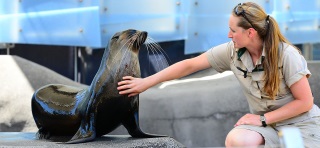
Image: Seal presentation at Melbourne Zoo, Chris Phutully, https://creativecommons.org/licenses/by/2.0/deed.en (cropped)
Many large modern cities have a good underground aquarium, and the Sea Life Aqauarium at the corner of Flinders Street and King Street opposite the river is a good one and probably a little different to most. A uniquely southern hemisphere highlight is the penguins, including the giant Emperor Penguins. The other main highlight is the large walkthrough perspex shark and stingray tank that you can also pay to go diving in. There is also a small place to feed the fish from for a few dollars.
The Government runs three zoos, and they are at the high quality you would expect for a city of its size.
Melbourne Zoo is 3 kilometres north of the city in Royal Park. It has quality natural looking vegetated enclosures housing predominantly overseas animals, mostly from Asia including elephants, monkeys and a popular butterfly house that little children especially enjoy. The seals and penguins are good too, and there is a building full of exhibits of native snakes and lizards. However, foreign visitors might be a little disappointed that there is only one section of the zoo which has kangaroos, koalas and other cute Australian native mammals, and you will not be allowed to get close, hold or feed them with a general admission ticket to the zoo. Consider day tours that include visits to privately run wildlife parks for that, like the Phillip island tours, for a closer personal experience with cuddly koalas, less cuddly reptiles and other native species. http://www.zoo.org.au/melbourne
Healesville Wildlife Sanctuary is 50 kilometres east of Melbourne in the Dandenong Ranges housing exclusively native Australian wildlife, but you will not get hands on them here either with a general admission ticket. Getting to the sanctuary by public transport is difficult and time consuming. It will take at least 2 hours. http://www.zoo.org.au/healesville
Werribee Open Range Zoo is 30 kilometres southwest of Melbourne and has both Australian and overseas wildlife. Part of the zoo is open range, part is not. The last safari tour leaves at 3.30pm. Nearby is the historic Werribee Park Mansion which charges separate admission. Take the freeway towards Geelong and exit at Werribee South to K Road. http://www.zoo.org.au/werribee
Melbourne city centre is almost wholly surrounded by English style parks and gardens with large lawns. For large tracts of native forest you would be best to go to the eastern edge of the city to Mount Dandenong for a bushwalk - see the day trips and longer section below.
The Royal Botanical Gardens is in the Kings Domain parkland just south of the city centre across the Yarra River. Many Melbournians like to relax and pass the time on the lawns there on warm weekend days. A favourite for young children is exploring the junglely pathways and tiny creek in the childrens garden section of the gardens near the Observatory entrance. Also in Kings Domain just across the road from the Observatory is the Shrine of Remembrance - see museums above. A shady 3.8 kilometre running track, called the Tan Track, popular with city office workers taking a break and inner city mums with prams makes a fool loop around the outside of the botanical gardens.
Just to the east of the city are the tranquil Treasury Gardens. Immediately beyond that the larger and even more beautiful Fitzroy Gardens. Captain Cook's Cottage has been reassembled in Fitzroy Gardens - see museums above. Captain Cook was the first Englishman to sail along and chart the east coast of Australia in 1770. http://www.fitzroygardens.com http://www.shrine.org.au/
To the north of the city are smaller Flagstaff Gardens near the Queen Victoria Market, and the Carlton Gardens where the Old Exhibition Building and Melbourne Museum are located - see other historical buildings and museums above.

Image: St Kilda Beach and Pier, Melbourne, avlxyz, https://creativecommons.org/licenses/by-sa/2.0/deed.en (cropped)
The busy inner beachside suburb of St Kilda is 7 kilometres south of the city and is the number one trendy place for younger Melbournians flock to on warm days to lay on the sand, cool off in the water, or just go for a walk, cycle or rollerblade along the beachfront promenade. A walk along St Kilda Pier to the old wooden cafe at the end is also nice. You can keep walking from the cafe along the path on the rocky harbor sea wall, and if you are lucky you might see a penguin or two amongst the rocks or swimming in the lea side shallows. North of the pier just past the boat harbor is the place for kite surfing (hire available) and will be busy if there is lots of wind.
On warm summer weekends the outdoor cafes, restaurants and bars on Fitzroy Street, Acland Street and on the beachfront are sure to be busy. We especially like a relaxing beachfront sunset dinner of seafood on a warm evening at Beachcomber. It is a casual gem of a restaurant in the old sea baths building on the foreshore and is probably more frequented by foreign tourists than locals. The fabled and grungy "Espy" (Esplanade Hotel) closed in May 2015 and the renovations look far from finished, so do not go there looking for indie rock bands. (That's why its good to read a locally written travel guide that is up to date, and not a leading global guide that is months out of date.)
On Sunday there is a crowded craft market the whole length of the Upper Esplanade.
Though St Kilda was once a thoroughly seedy red light district, the influx of arty types and wealthier yuppies into the area has changed it. I do not want to overplay it, but elements of the seedy, red light and downtrodden past remains in some parts away from the main beachside area. This is especially so along Grey Street, parts of Carlisle Street, some side streets in that vicinity and the open air car park off Acland Street. Illegal street prostitution is blatant. (I doubt any other Melbourne travel guide will tell you that.) I have only ever felt uneasy in those places, never unsafe.
Luna Park is an old style rollercoaster and amusement park at the corner of Acland Street and Carlisle Street. The giant mouth people walk through to enter the park is iconic, though there is another at Luna Park in Sydney as well.
Both Bourke Street and Swanston Street trams from the city go to st Kilda Beach. Or you could even walk from Balaclava railway station, though it is a 2km hike. The main shopping street of Balaclava, Carlise Street, is itself is a bit of an interesting contrast with discount variety stores catering to the surrounding low income flats, mixed with bars for trendy types as the area becomes increasingly an overflow from St Kilda bars, and wealthy orthodox and ultra orthodox Jews who make the majority of the people in the surrounding area.
Brightly painted wooden beach boxes are a postcard image of Melbourne, popular especially amongst Chinese and Japanese tourists. But you will not find any at St Kilda Beach. The closest are further out of the city at Brighton Beach. This is a quiet and affluent suburb 25 minutes by train from Flinders Street Station. The beach boxes are at the end of Dendy Street, which is 1km north (towards the city) from the railway station. If you enjoy exercise, you might also consider a 10km bike ride along the foreshore bike track from St Kilda to Brighton Beach and back. Brighton is about 15km from the city so you will need a really good telephoto lens to get the classic photo of the beach boxes in the foreground and the city skyline as a distant backdrop. If you are venturing further out of Melbourne, there are other good groups of beach boxes on the Mornington Peninsula at Mornington and Portsea.
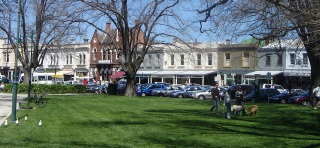
Image: Williamstown, Melbourne, en:User:Frances76, https://creativecommons.org/licenses/by-sa/3.0/deed.en (cropped)
This mall between Swanston and Elizabeth Street marks the historical epicentre of the city shopping precinct. Two large and long established departments stores are on the mall, Myers and David Jones. Expanding out from the mall, shops largely fill the entire area between Swanston and Elizabeth Street. Two large shopping centres, called Melbourne Emporium, and immediately after that, Melbourne Central extend to the north up to La Trobe Street, QV is to the east on Lonsdale Street and Australia on Collins (currently under re-development) is to the south. Collins Street itself is known for upmarket boutiques. Cafes in the many laneways and arcades around the shopping area make a nice stop for a quintessentially Melbourne coffee or lunch.
Melbourne has had a significant Chinese community since people started flocking to the region looking to make their fortune during the early gold rush years from about 1850. Chinatown in the city centre is a bustling area on Little Bourke Street (between Swanston Street and Exhibition Street) lined with mostly Chinese restaurants for two whole city blocks. More Chinese student orientated eateries overflow into surrounding laneways and onto Swanston Street and Russell Street. For the Chinese Museum, see museums above.
Just south of the city centre over the Yarra River is the arts precinct of South Bank. The first building over the Swanston Street bridge onto St Kilda Road is the round shapaed Melbourne Concert Hall. Next door to that is the also round shaped State Theatre, easily recognized from its tall spire that was once used as the symbol of Melbourne. Next along is the rectangular stone building with moat which is the main part of the National Gallery of Victoria - see art above.
Along the south bank of the Yarra River from the Swanston Street bridge to the casino is a busy promenade of many restaurants with views overlooking the city. It is a pleasant and popular area for lunch or dinner on a warm day, or just a stroll. There will frequently be a few buskers along the walk. Heading the other direction along the river bank past several rowing boat sheds is parkland. For those who like activity, a pleasant meandering bike path leads upstream from there for many kilometres.
Increasingly new skyscrapers are being built in Southbank. Melbourne boasts all ten of the tallest ten buildings in the southern hemisphere (when measured from the top floor, not the tip of the spire which makes Q1 on the Gold Coast taller). The Eureka Tower midway along the promenade, and behind the first row of office buildings, is the tallest of all in Melbourne. From the Eureka Skydeck near the top of the building on the 88th floor it is possible on a clear day after rain to clear the smog to see as far as the narrow entrance of Port Phillip Bay, the almost full circular bay upon which Melbourne are nearby Geelong are built. https://www.eurekaskydeck.com.au/
Crown Casino is at the end of the main part of the promenade along the river. It is a mammoth complex and much more than a casino. When it was constructed in 1997 it reputedly had the more gaming tables than any other casino in the world. As well as the casino there are many exclusive clothes shops, popular riverside restaurants, a cinema, nightclubs, bars and three hotels. In the evenings on each hour the flame towers outside along the river release huge bursts of flame, and the biggest chandelier in the world in the foyer has a light and sound show. In our view, the Crown Towers Hotel is the most opulent and the top choice in Melbourne for a romantic city weekend.
Chapel Street in South Yarra, 4km south of the city, has a long strip of classy fashion shops, restaurants, pubs and nightclubs for the hip crowd. On Friday and Saturday nights Chapel St traffic is bumper to bumper with car stereos blaring at full volume. The action overflows onto the cross roads. These include Toorak Road which is generally more upmarket. The second cross road, is Commercial Road, which is a gay strip. The further south you go along Chapel Street from there into the next suburb of Prahran and then into Windsor the cheaper and grungier things get. Greville Street in Prahran (off Chapel Street) is retro cool.
Lygon Street is Little Italy. Choc full of Italian restauarnts, overflowing onto the pavement for alfresco dining makes it always a busy evening area. It is a pleasant tree lined road in the old established inner city suburb of Carlton just north of the city centre. The mostly double storey shop houses giving it a definite charm. Continue up Russell Street from the city centre on foot or by bus to get there, or take a Swanston Street tram headed to East Coburg.
Fitzroy it definitely the home of alternative lifestyle in Melbourne. It is an old inner city suburb just north of the city centre, and frankly it is fairly scruffy - but people who go there obviously seem to like that. There are a decent number of restaurants and bars along its main street, Brunswick Street, as well as along the next main street west which is Smith Street, Collingwood. Fitzroy is a shabbier suburb than nearby Carlton. And Collingwood is edgier to the point of a little dangerous in my opinion due to the drunken junkies hanging around. Maybe I am just showing my conservative personal tastes in saying some of this, but I am sure there would still be plenty of people who would agree with me.
Williamstown is a pleasant historic beachside and shipbuilding suburb that is all out by itself about 30 minutes by train south-west of the city. That makes the suburb its own relaxing little centre of activity. The main street facing the foreshore is nice for a cafe lunch. There is a small shady park opposite. The sandy Williamstown Beach is further away at the end of the suburb.
We have not forgotten St Kilda Beach. We have already devoted one full separate section above to it there is so much to say.
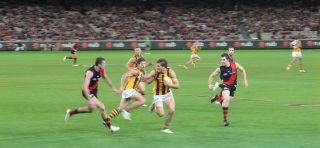
Image: Australian Rules Football at the Melbourne Cricket Ground (MCG), Simon, Mandy, Joshua, Bradley and baby Karla Yeo, https://creativecommons.org/licenses/by/2.0/deed.en (cropped)
Melbourne is the mecca of Australian Rules Football, or AFL of just 'footy' for short. The whole city is mad about the game. The season runs during winter with finals in September. Try to make it to a big game at the Melbourne Cricket Ground (MCG) or Docklands Stadium during you're visit to Melbourne. http://www.mcg.org.au
Other major sporting events are:
The bi-annual Air Show at Avalon Airport (odd years in February/March) is the biggest military and civilian airshow in the southern hemisphere, so also a significant draw card. It is great. (Technically, I think aero-acrobatics is a sport, so the event has a justified place in this major sporting events section.)
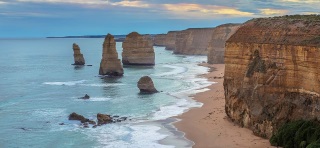
Image: Twelve Apostles at sunset, Great Ocean Road, Victoria, Leonard Koh, https://creativecommons.org/licenses/by-sa/4.0/deed.en (cropped)
The Great Ocean Road runs 300 kilometres along rugged coastline of spectacular cliffs and some great surf beaches. It is one of the great coastal drives in the world and starts about one hour out of Melbourne. The highlight is the 12 Apostles rock formation near its far end in Port Campbell National Park. Dozens of tours buses leave Melbourne very early each day for the very long day trip, stopping along the way. Of course it is much more relaxing with a hire car stopping overnight or longer at small attractive beach towns along the way like Lorne or Apollo Bay so you can enjoy the beaches, waves, waterfalls and the cool tranquil rainforests of Cape Otway at your own pace. There are many holiday homes along parts of the coast closer to Melbourne, but it gets quieter as you put more distance between you and the city.
The coast earnt the reputation as the shipwreck coast with over 100 sailing ships and steamers wrecked on the cliffs in often treacherous weather. A little further west along when the coast flattens out is the town of Warrnambool. The Flagstaff Hill Maritime Museum there is a reconstructed village from the era when it was a whaling town and the main building shows some of the history of the ship wrecks.
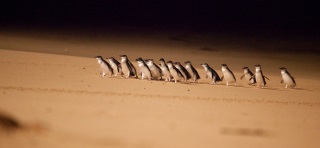
Image: Penguine Parade, Phillip Island, Victoria, Phillipislandtourism, https://creativecommons.org/licenses/by-sa/4.0/deed.en (cropped)
Just after dusk each day hundreds of cute little fairy penguins come to shore at one particular beach on Phillip Island after spending the day at sea hunting fish. They waddle across the beach to their burrows in the sand dunes. A favorite with Chinese and Japanese is afternoon or day-long bus tours from Melbourne. There is more to the island than the penguins parade. There are a number of wildlife parks both on and off the island where you can get up close and personal with koalas and other native Australian animals, and some good beaches for swimming and surfing too.
The island is connected by a bridge to the mainland. Off the island about 30km away in Wonthaggi is the State Coal Mine. The mining ended some time ago and it has now reopened for underground tours.
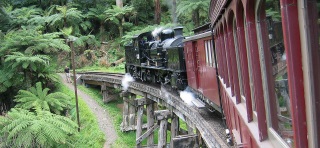
Image: Puffing Billy on trestle bridge near Belgrave, Mount Dandenong, Victoria, Stephen Edmonds, https://creativecommons.org/licenses/by-sa/2.0/deed.en (cropped)
Take a peaceful bushwalk amongst the dense tree fern and mountain ash forests on Mount Dandenong, browse the curio and art gallery shops in the quaint little mountain towns and have a bite at the English-style tea rooms and cafes. The base of the mountain is at the edge of the city so makes for an easy day or weekend getaway for locals to enjoy the cool crisp mountain air.
Olinda is the main and busiest town on the mountain. We like Grants Picnic Ground area for feeding the cockatoos and walks, and at The Observatory on the top of the mountain for a view over Melbourne in the distance. Puffing Billing is a slow narrow gauge steam train that winds its way deep into the hills from Belgrave Station. It is an icon to locals and a special favorite for children to travel on with its open side carriages. Most passengers get off at Emerald Lake for a picnic lunch and make a day of it.
The Yarra Valley wineries and vineyards are in the vicinity for wine tasting, cellar door sales and several have restaurants. The town of Healesville is here, and the Healesville Sanctuary native wildlife park is just outside the town. See wildlife above.
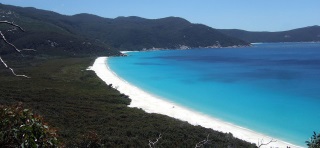
Image: Waterloo Bay at Wilsons Promontory National Park, Victoria, Steve Bennett, https://creativecommons.org/licenses/by-sa/2.0/deed.en (cropped)
Surface gold was first found near Ballarat in 1850. A gold rush followed with a large influx of people all trying their luck in small diggings. 'Eureka' they would shout to express the great joy on finding gold. Some people made their fortune, as testified by the grand buildings in the bigger old gold mining towns. However many people struggled to find much. Mining license fees they paid were high, leading to a revolt by the miners against the Government called the Eureka Stockade.
Sovereign Hill in Ballarat is a recreation of an 1860s Australian gold mining town with traditional style ironsmiths, baker, lollyshop and others. Kids enjoy panning for alluvial gold in a stream there. A light and sound show at night relives the stockade. By the 1880s much of the shallow buried gold had been found and larger mining companies began to sink deep shafts.
If you want to go on a tour down a real gold mine, Central Deborah Gold Mine in Bendigo will give you that experience for an hour or longer with experienced guides, quite a number of whom worked in the mine. There are numerous other small historic gold mining towns in region that attract visitors. Of those two in particular attract a decent tourist trade. They are Maldon for its original character and antique shops that have been retained, and Daylesford for spas fed from nearby Hepburn Springs.
Echuca, is the closest town to Melbourne on the Murray River. It was a river port town in the early days of Europena settlement. Paddle steamers used to ply the rivers collecting wool from farms and delivering it to one of the railheads for transportation to Melbourne. The tourist highlight in Echuca is the old wharf area museum, warehouses and historical display. Included in the historic precinct is the nearby Star Hotel and Bridge Hotel. The original steam powered PS Emmylou has cruises. There are also houseboats to hire to travel along the river for overnight or longer. Much further downstream are other historic river port town of Swan Hill and Mildura.
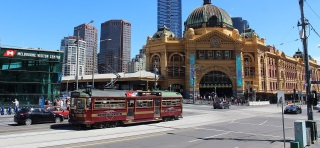
Image: City Circle Tram, Information Centre and Flinders Street Station, Melbourne, Liamdavies, https://creativecommons.org/licenses/by-sa/3.0/deed.en (cropped)
Melbourne Visitor Information Centre is centrally located in Federation Square. You can easily see the entrance from Flinders Street Station opposite. There are plenty of brochures and maps, and helpful staff with suggestion about attractions to visit.
Melbourne has a good city wide public transport system. Melbourne is divided into two transport zones; an inner zone 1 which includes the central business district and inner and middle suburbs (yellow on maps) and zone 2 for the outer suburbs (blue on maps).
Travel on all metropolitan services is with a Myki card purchased at major railway stations or 7 Eleven convenience stores. The card costs $6 (or $3 for children). The card has no credit on it when purchased. You need to top up the card balance with money. The balance is not refundable.
Hold the card to the pad on the light green scanner when boarding trams and buses and at railway station platform access points. The fare is automatically deducted from the account balance. A good habit is to hold the card to the scanner again when getting off so you are not charged for travel in both zones.
Travel cost is approximately $4 for unlimited adult travel for 2 hours (measured from the last boarding time) or $8 for all day, and half those amounts for children. You do not need to worry whether the Myki card balance is enough for a single trip because you just need to have a positive balance when boarding to be allowed onto the vehicle or into the railway station. For example, if you had only $1 balance on the card, you can board, the $4 fare will be deducted making the card balance negative and you will not be allowed to board another tram or bus or enter another railway station until you top up the balance to a positive amount again.
Trams travel in the central city area is free. See below.
The Melbourne metropolitan train network consists of about a dozen lines that radiate out from a city loop of 5 stations to the outer suburbs. Most trains run around the city loop before heading to the suburbs. However some trains run directly in and out of the city from Flinders Street Station, including all services on bayside lines on weekdays. For this reason many passengers from city loop stations need to interchange at Richmond or North Melbourne for the correct line.
Trams run along most streets in the central city area, and most routes radiate from there to the inner and middle suburbs. Melbourne has the largest tram network in the world! Tram travel in the central city area is free, making it an especially good way to get around to most tourist sights. There is also a tourist tram operated in old wooden W-class trams around a city circle and from there to New Quay shopping centre at Docklands and back. It is also free.
Buses are generally only in the outer suburbs to get passengers to the nearest railway station or large shopping centre. They also operate from the city centre on Queens Street, Lonsdale Street an d Russell Street to the few parts of Melbourne that are not serviced well by train or tram routes.
The radiating design of the public transport network will generally mean that travelling across town any significant distance is quickest done by going back into the city and out again.
The last services leave the city just after midnight. Outer suburban buses generally stop much earlier, and some may not run on Saturday afternoon or on Sunday at all. Trains and some tram routes run all night over Friday, Saturday and Sunday night, though the service is not frequent. The regular transport system only starts surprising late on Sunday morning, and some trains and buses might be only once an hour on Sunday.
Taxis are easy to spot. They are mostly all yellow with a green and yellow chequered trim. Some have a green roof too. The newest (and cleanest) taxis are generally silver or white. All taxis should be equipped inside with safety cameras mounted on the rear view mirror. If the white light on the roof is on that means the taxi is available. Silvertop Taxis phone 131 008. Black Cabs phone 13 227. Flagfall is approximately $5 then $2 per kilometre, extra for toll roads and airport pick up. Prices are only very rarely able to be negotiated.
Large city centre hotels will often be able to assist with hiring a car. The major hire car companies like Avis, Hertz and Europcar all have offices and car yards on Franklin Street (between Elizabeth Street and Swanston Street) and at the airport. Expect to pay approximately $70 per day including insurance. A hire car will probably be more a nuisance that a help in the inner city due to traffic congestion, shortages of on-street parking and parking station costs.
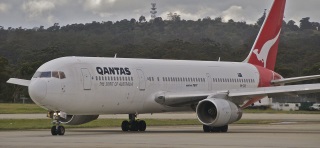
Image: Qantas Boeing 767-300ER airliner on the tarmac at Melbourne Airport, Aero Icarus, https://creativecommons.org/licenses/by-sa/2.0/deed.en (cropped)
Melbourne Airport (formerly called Tullamarine Airport) is main airport for Melbourne and has international and domestic connections. It is 22 kilometres northwest of the city centre and is only readily accessible by toll road. Either catch a taxi ($60 to the city) or the red airport shuttle bus ($12) which runs frequently to and from the V-line intercity bus station on Spencer Street. Smaller buses provide hotel transfers from there. A few Jetstar flights instead use Avalon Airport 50km from the city centre towards Geelong.
Prices for domestic air travel vary a lot depending on demand at the time and the day you want to fly. If you are flexible about exactly what time and which day you want to travel then flights costs are reasonable.
Major domestic carriers are Qantas and Virgin Australia, and their discount offshoots Jetstar and Tiger respectively.
Spencer Street Railway Station (corner Collins Street) in the hub for long distance trains to regional Victoria, Adelaide and Sydney. The overnight Sydney train has sleepers. Most suburban trains also stop at the station. The main long distance bus station is also on Spencer Street (corner Lonsdale Street). A shopping centre separates the railway station and bus station.
A ferry for passengers, cars and trucks runs between Melbourne and Devonport in Tasmania overnight every night, and also every day during summer. The ferry is operated by TT-Lines and leaves from Station Pier in Port Melbourne. The pier is accessible via tram route 109 from the city west along Collins Street and takes 30 minutes.
(c) Copyright Graham Warren, Melbourne 2016. TM trademark emubook, emubook.com, emubook.com.au and the e-symbol. All photos used under noted licences.